Think about how much product development a business can undertake in 43 years. For a proactive group of passionate individuals, like the folks at Cameron Campers, the possibilities are endless. By blending their tried-and-tested experience with the latest computer-precise fabrication technologies, they’ve produced the Conquest, a Space Age camper backed by old-timey wisdom.
I met up with Bronte and Tamara in the foothills a half-hour drive from their manufacturing facility in Lonsdale, to check out this highly innovative RV of theirs. Given their campers are conceived and made in South Australia, from Australian materials, Cameron Campers can customise and engineer for ergonomics until the product meets their rigorous standards. Buyers will reap the rewards.
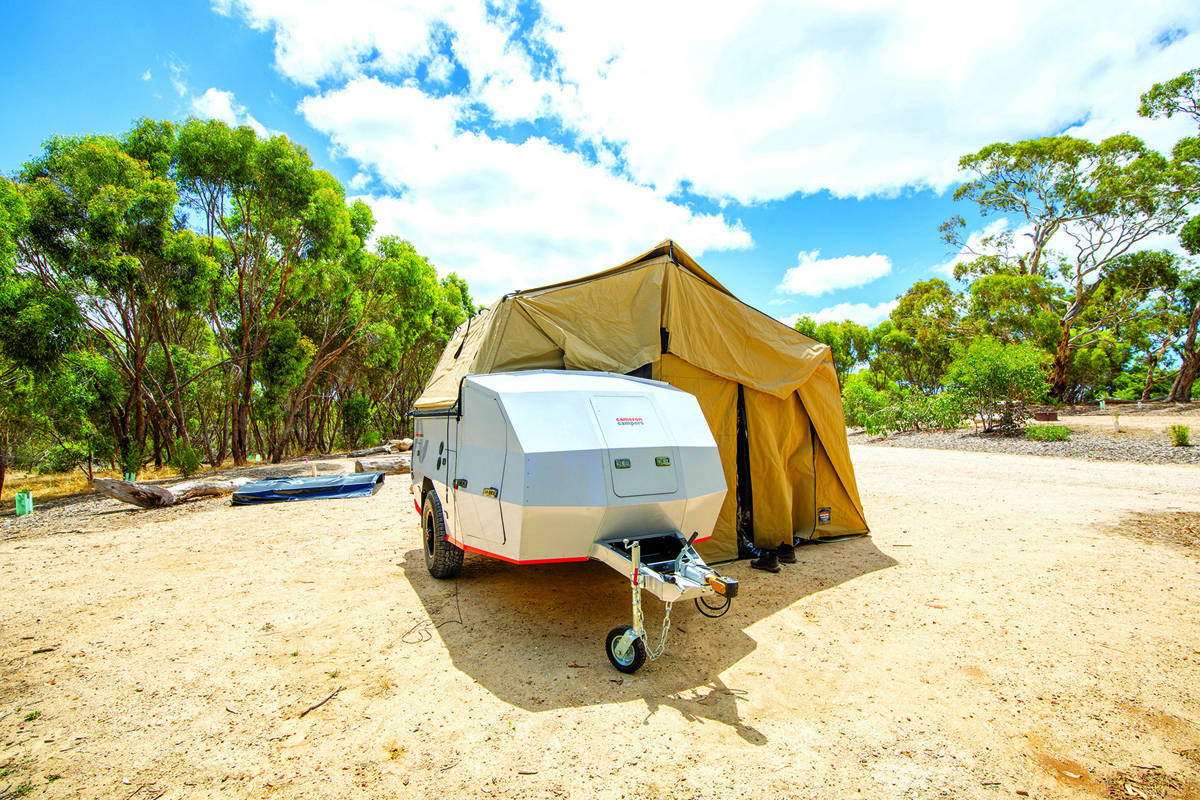


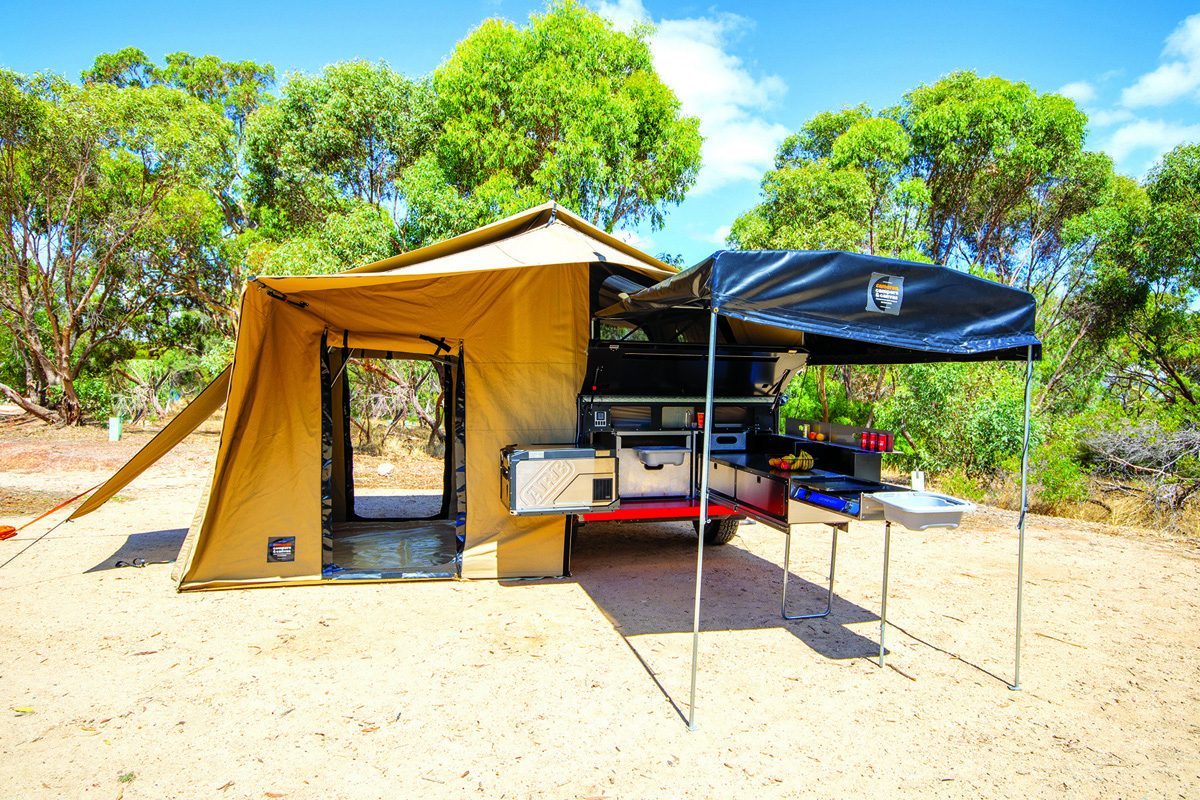
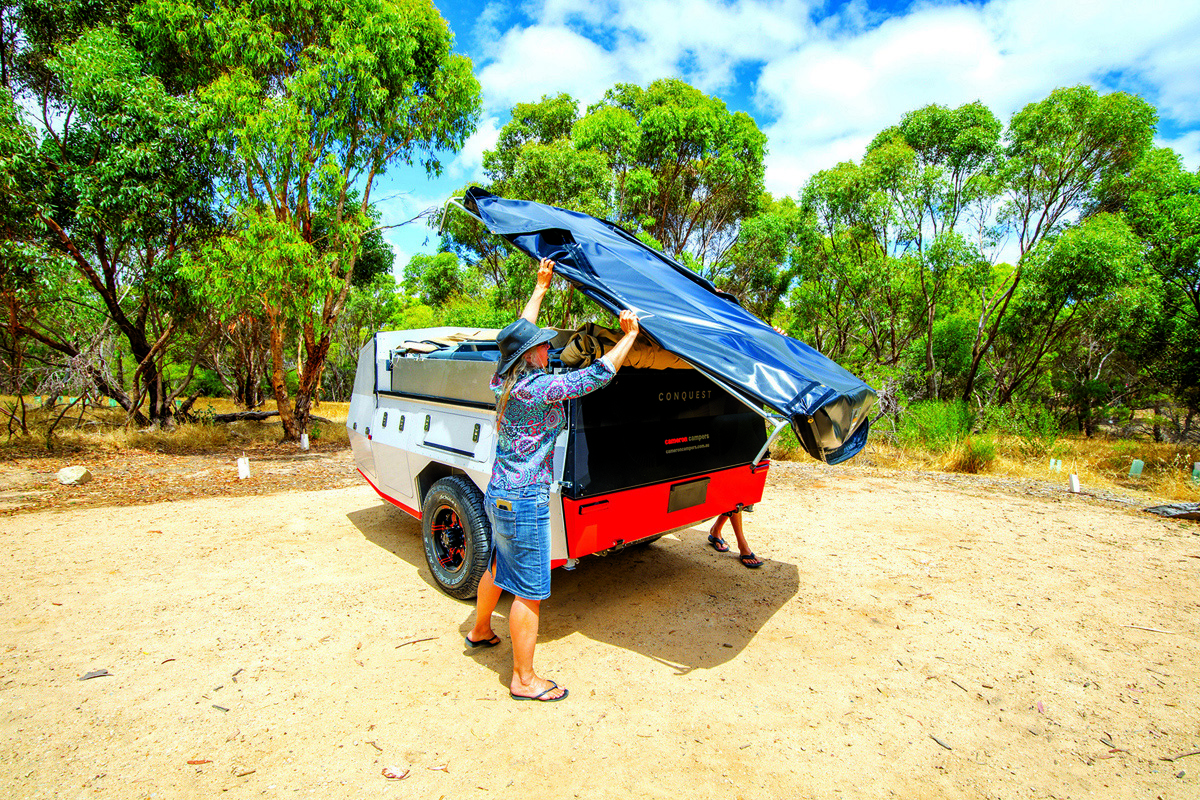
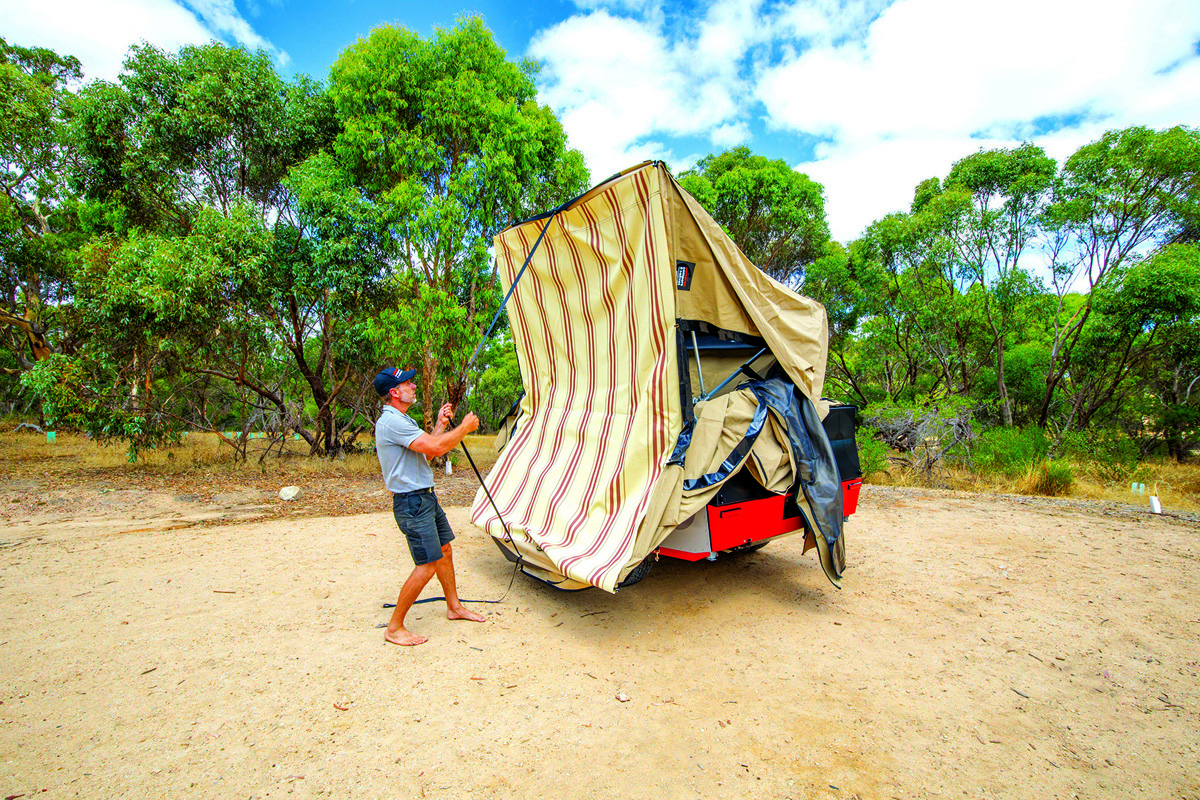
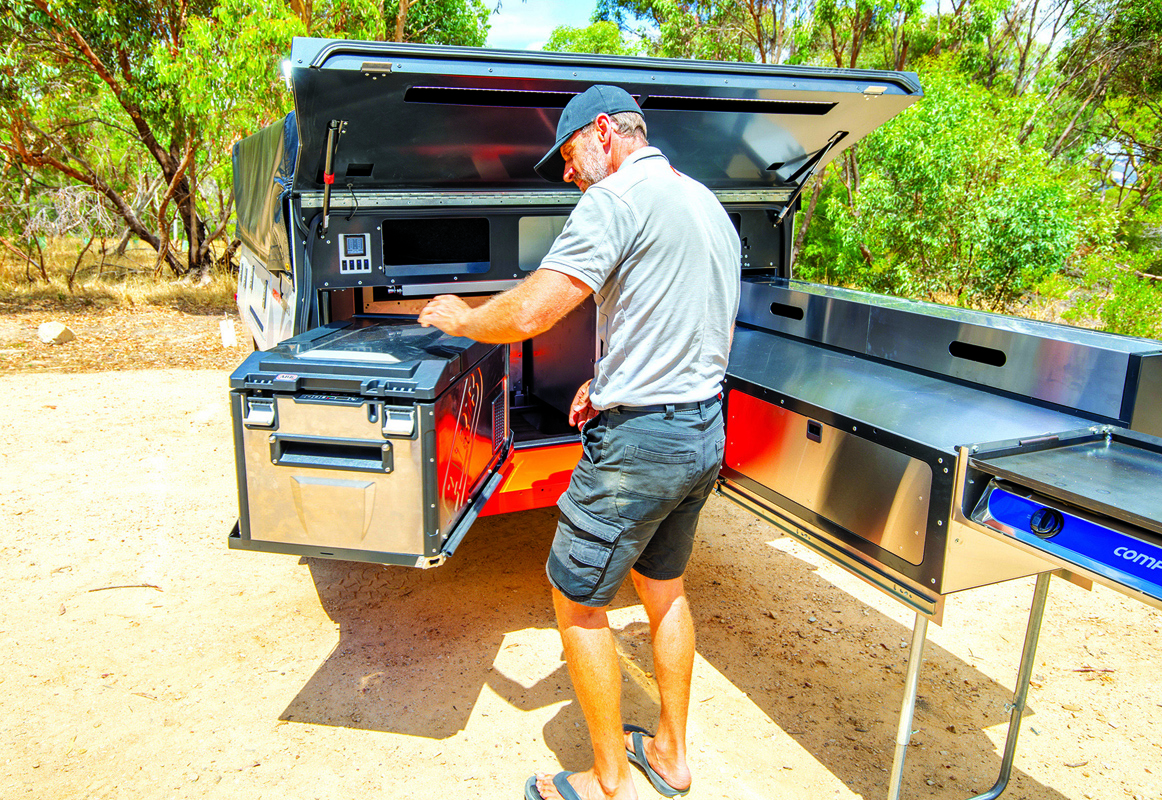
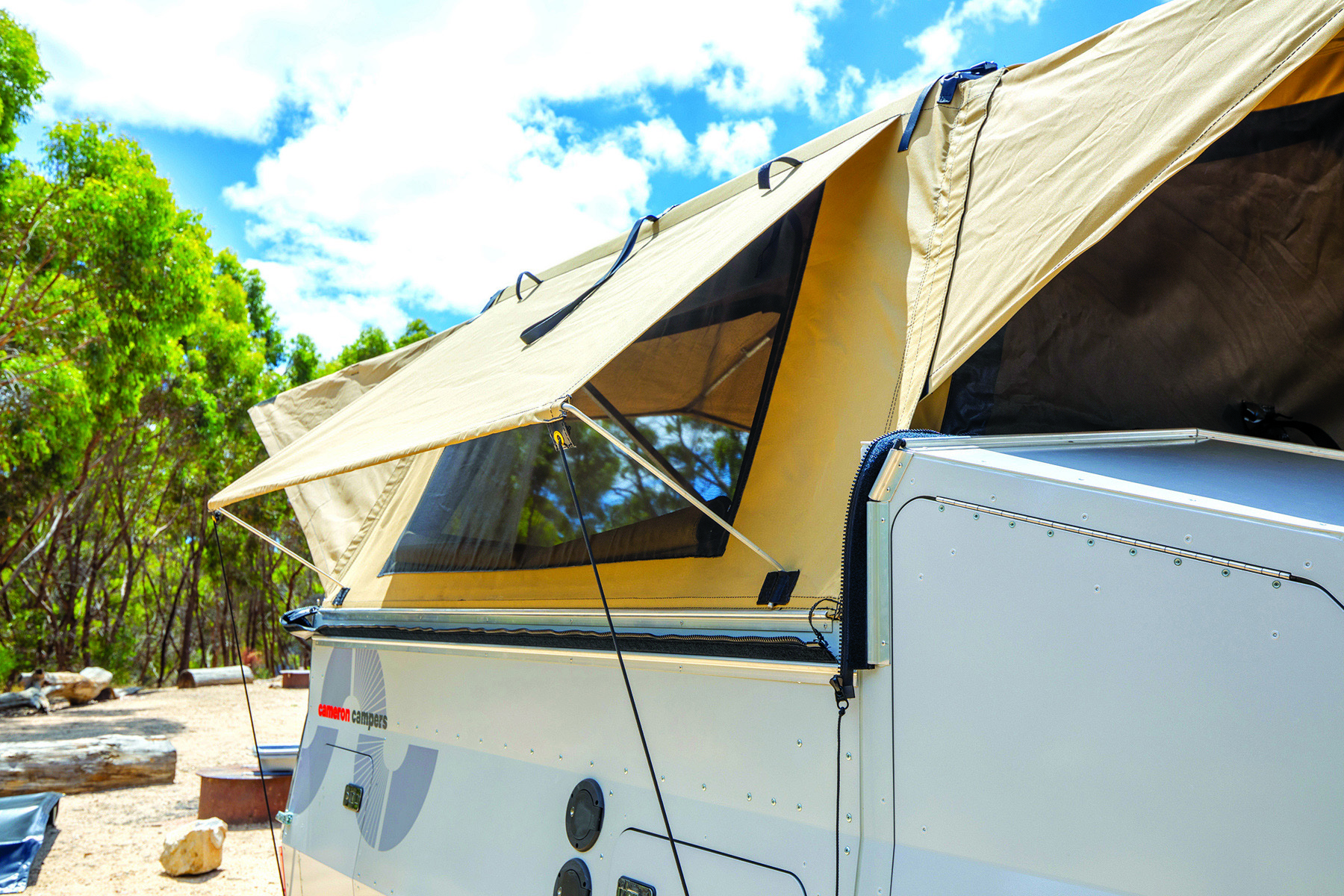
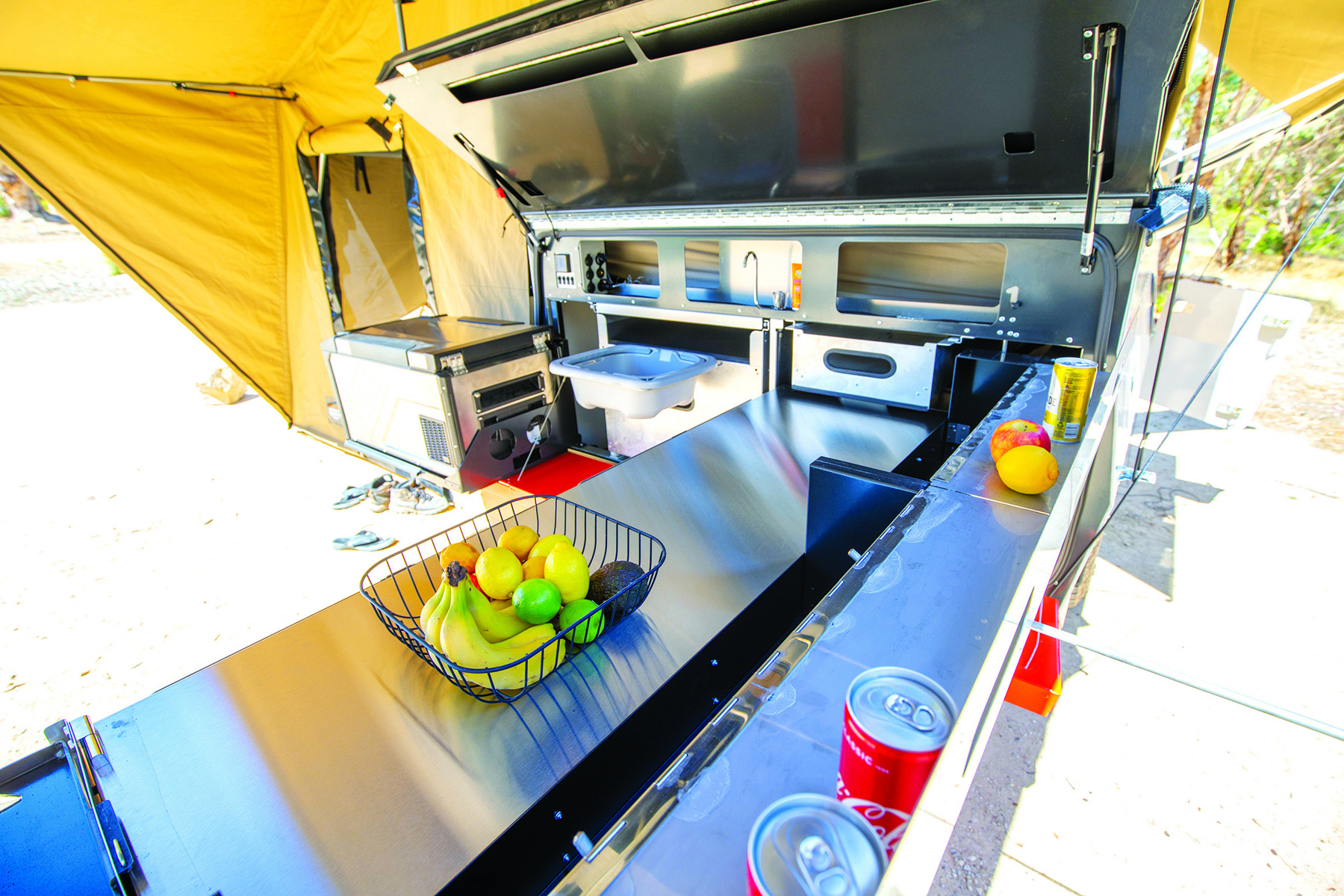
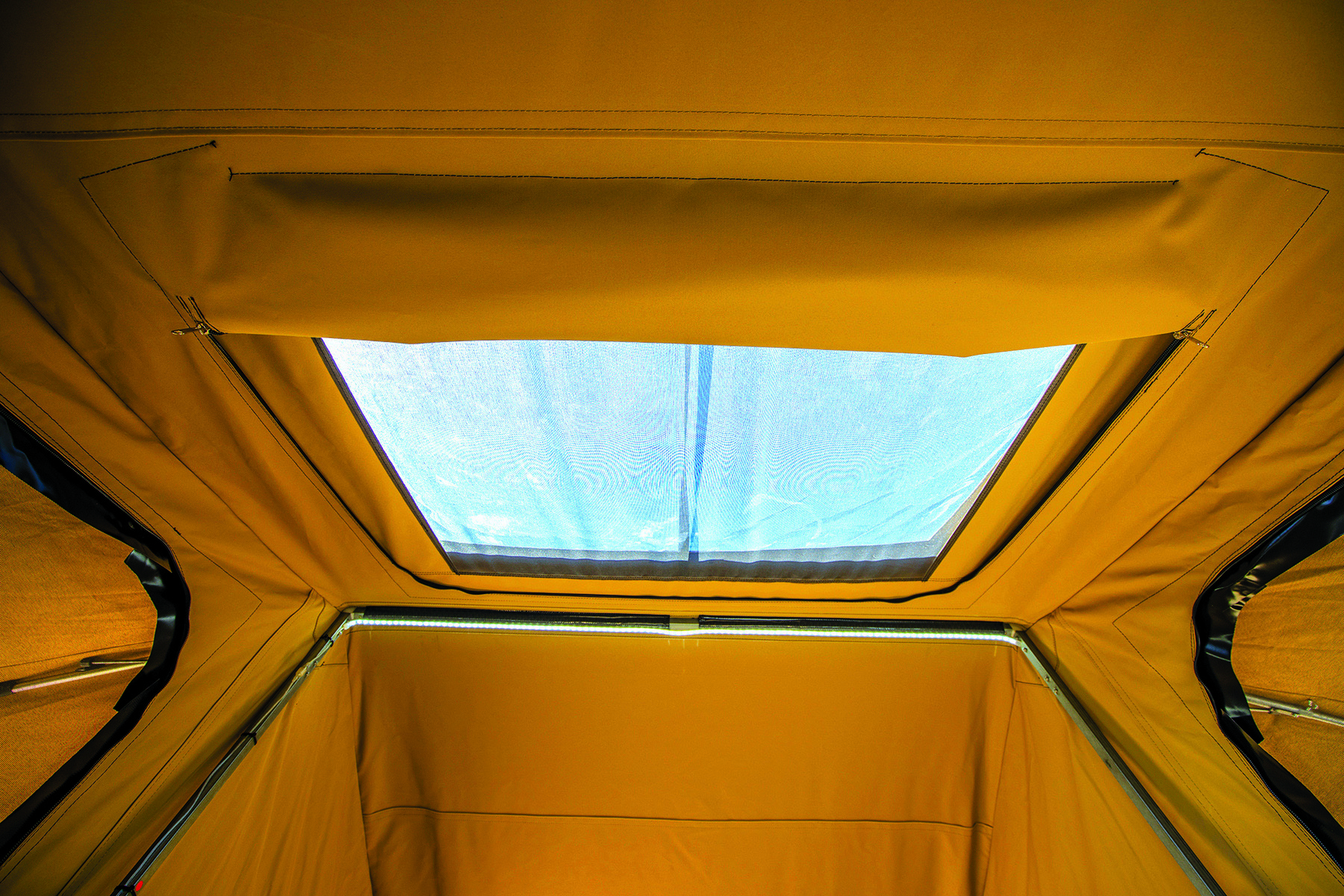

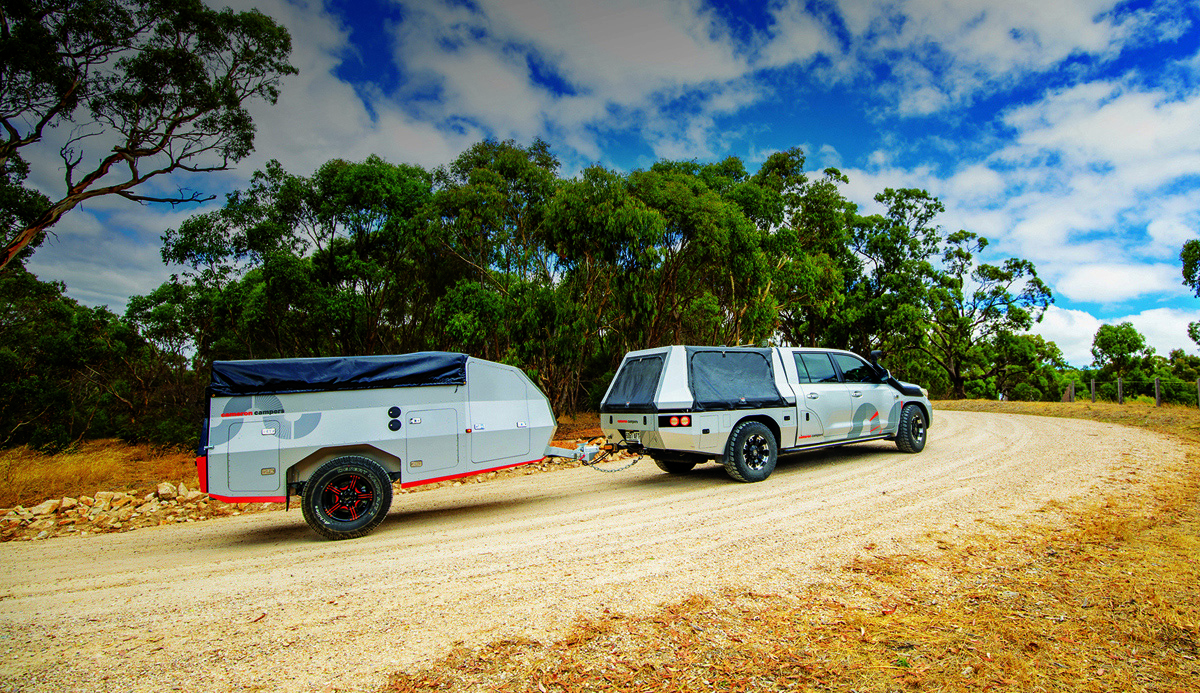
RIDING IN THE ROUGH
A Treg polyblock hitch comes standard but can be swapped for another hitch if preferred. Cameron Campers have deliberately included a removable jockey wheel, to ensure maximum clearance and minimise spaces where mud and stones can catch. Having no jockey wheel on the drawbar during transit also reduces the chance of stones taking out the tow vehicle’s rear window. The angled nose cone of the camper body deflects stones away, too.
Back from the hitch, the drawbar is contained within the front nose cone. Not having it exposed for the full width of the underside makes it impossible for mud, dirt and other junk to become stuck, which improves ease of cleaning and durability. Underneath, zero wiring or piping is exposed. Huge bash-plates offer comprehensive protection.
The only item to observe is the trusty seven-leaf ALKO leaf-spring suspension, supported by a shock absorber each side and limited by plump bump stops. The disc brakes are mechanical override, so you won’t need a brake controller installed. The Conquest features two drop-down support legs at the rear, which are recessed within a hollow section in the frame when not in use. Again, the lack of exposure improves clearance and minimises cleaning obligations.
Almost all vehicles with a towball can handle the Conquest’s 880kg tare — likewise, its ATM of 1850kg is fair game for SUVs. Loading the nose cone adds weight to the ball but towing remains balanced, with most weight over the axle, including twin 59L poly-prop water tanks either side. The camper body angles in at the bottom so is less likely to scrape against branches or rocks as the camper tilts off road. Dimensions are compact — 1.9m across, 4m long, and 1.83m high.
Cameron Campers have achieved the light weight by using marine-grade aluminium in place of steel and by reducing weight in non-structural areas. Yet the trailer is built tough. The panels are designed on SOLIDWORKS — subsequently, the computer talks to laser cutting and folding machinery before all parts are glued together and riveted. A final application of Silver Pearl powdercoat adorns the aerodynamic, spacecraft-like body.
EXTERNAL STORAGE
The front nose cone has a whopping capacity of 1800L and is accessed via three large doors (one front, one right, one left), which hinge upward, butterfly-style. The cone could easily hold a Weber, camp chairs, a table, a bike, a Finska lawn game, a porta potti, an esky, diving tanks, a tackle box and a bag of firewood, or similar. Against the back wall of the cone, on the left, the spare tyre straps on upright. Across the top of this back wall there’s a shelf for storage. Within it, there’s 12V power and light switches which activate flush LED lighting of the cone. At the back of this shelf, you can reach into the bedside storage, whether the camper is set up or not.
Towards the front on the passenger side of the trailer, a drawer nearly the trailer’s full width slides out. The space is open so it’d be ideal for clothes in tubs, which could be pulled out and packed at home or carried to a campsite laundry. The free space under the drawer can be accessed when the drawer is in, or when it is out if you open the nose-cone door and reach into a cut-out in the back wall.
Above the wheel arch on the passenger side a short, wide compartment features a 100Ah AGM battery, a generous Narva fusebox with lots of spares for customisation, and the AC/DC Projecta Intelli-Charge charger. Power can be extended to a maximum of 240Ah across two batteries. A 200W portable solar panel can be optioned on, as can a 600W inverter for low-draw 240V appliances. Within this compartment, carpeted space allows for extra storage.
At the front on the driver’s side, a compartment houses three jerry cans on a flat shelf, which secure with pre-installed straps. The shelf removes to reveal a small section of additional storage below. There’s nothing over the wheel arch. At the rear, a compartment holds one or two 4kg gas bottles. One bottle remains plumbed and the hose coils up when not in use. All compartments are lockable.
To milk the storage potential for all it’s worth, you can store items under the PVC road-cover when packing the camper away. If you’re into DIY, you could make false-floors and put them into the slide-outs. Finally, there’s heaps of storage space accessed from the kitchen — as we’re about to find out.
KITCHEN EXTRAORDINAIRE
The rear-facing panel of the camper has two doors, an upper and a lower. These hinge up and down respectively, right from the edges, revealing the biggest possible operative space. The upper door hinges with help from gas struts and holds at a diagonal — it features a recessed LED light to illuminate food prep. The lower door drops and holds at 90-degrees. Inspired by a LandCruiser tailgate, it’s strong enough to sit on.
On the kitchen’s right-hand side, you release a spring-loaded pin to pull out a large slide. As with all compartments, there’s no handle, but instead, a cut-out hole that acts as one — observe the weight reduction principles. This working surface, as with all within the kitchen, is stainless steel.
Off the end of this major slide, the Companion two-burner cooktop flips over 180 degrees. Simply hook the gas hose from the plumbed bottle to the quick connect fitting and you’re cooking. Without opening the side compartment, you can access the strapped-in gas bottle and hose from the back when the kitchen is open.
This cooktop can hold a custom-made hot plate for BBQ cooking and is supported with an adjustable-length leg, to go with the U-shaped support leg that swings out from under the slide-out. Despite being so far out from the camper body, the arrangement is sturdy.
From the inside vertical face of the major slide, two drawers slide forward. Meanwhile, over the flat prep space on top, a detached drawer slides out parallel, occupying only the left-hand side. Complementing this in the space to the right (or along the back of the workspace if you’re standing at it) are two in-built raised compartments, with L-shaped lids that flip back. These have drainage holes so you can load them with ice to keep drinks or whiting fillets cool.
On the left-hand side of the rear-facing kitchen space, the fridge (a 95L ARB unit as seen) sits side-on on a custom fabricated tray. Rather than sliding out, the tray hinges 180-degrees until it’s held to the kitchen’s left. Incidentally, this is the passenger side, meaning it’ll open onto the footpath, not the highway.
I’ve never seen this design before and the way it frees up space is miraculous. Now, from deep within the guts of the camper, you can pull out a ginormous storage slide into the space the fridge occupied a moment ago. This slide runs along a track in the ceiling and has a cut-out in the front face for easier access. It slides along the length of the cooktop slide and can be fully removed for loading.
A water tank level gauge and several power switches adorn the strip of wall at the top of the kitchen. Behind the wall there’s a shelf recessed into the body, accessible through large rectangular holes. From this shelf, the water tap swings out into the prep space. Two USB, two cig and two merit plugs are easily at hand. On the wall at the back of this shelf, yet more cut-outs grant access to the bedside storage. If you pack up but leave your phone inside, you’ll be able to fetch it without setting up again!
Transportable sinks can be mounted in ten locations on metal U-frames that slot into pairs of holes in the vertical surfaces of the kitchen’s slide-outs and cupboards. These sinks double-stack, can be easily emptied away from camp, and generally offer greater versatility than a fixed sink. However, they aren’t right under the tap as with a fixed sink. Nor is there hot water standard.
SETTING UP SHOP
The top of the Conquest features a 620gsm PVC road cover supported on a metal frame. To set-up, first unvelcro and unzip the edges of this cover from the camper body, using the long pull-string to release the zipper where it is hard to access above the drawbar. The cover attaches at each of the four corners, with the option to use cotter pins for additional safety. Detach these corners and lift off the cover. Leave it close by — you’ll need it later!
Next, release a wide side panel to extend what will be the foot of the bed and swing the wide three-rung staircase into position. Then, locate the strap and, standing on the passenger side, pull it hand over hand to unfold the canvas structure. Gas struts do the heavy lifting for you. Once it’s down, use two straps to connect the tent to the camper’s underside, pulling the material tightly into place.
Next, step inside through a side door. All poles are captive, in the sense they are sewn into the roof and floor, so do not need to be fitted each time, merely adjusted to length. At first, there’s no wall on the camper side where the tyre is — close this space off by fitting a purpose-designed panel in with sail-tracking, zipping up the edges, and securing with velcro.
That’s the tent done in a matter of minutes. Back outside again, there’s a few final steps. The windows around the bed have slanting awnings with hollow metal rods along their ends. Supporting metal rods insert onto the main canvas and fix this awning rod a set distance from the window. Elastic from the awning then hooks onto tie-down points under the camper, preventing wind from changing the angle of the supporting metal rods.
A peaked self-supporting awning sets up either side of the soft-floor tent, over the entry points. They’d have to be one of the easiest awnings to set-up I’ve ever seen. You just release strips of Velcro and push up, then gas struts connected to the in-built poles flip the poles into place. These gas struts have locks, so they won’t close if a huge breeze pushes down or a wedge-tail eagle decides to perch. The pole ends then adjust to length with twist-locks, providing 1.5m of shelter out from the body. Both sides of the awning have vertical triangular side-wings, which shelter from angling rain and sun.
The outer reaches of the kitchen aren’t quite sheltered yet — it’s at this point that the road cover makes its comeback. The two attachment points at one end of the road cover clip into the diagonal upper door of the tailgate, which, again, will not go down unbidden due to locks on the gas struts. Two poles support the far end. The PVC cover even ‘folds over’ to cover the top edges of the vertical sides, to stop angling weather — but from the side near the soft-floor’s entry/exit (which you’d use for access), this can be folded out the way, so you don’t have to duck.
My one point would be that using the road cover over the kitchen requires leaving the kitchen door open. Depending on where you are camping you may or may not want to do that overnight. The road cover can also be used as an awning in various other places around the camper.
Cameron Campers have achieved a few unique points that shouldn’t be taken for granted with soft-floors. There are no guy ropes that could send you flying. Pegs aren’t necessary, so the tent can be set up on concrete or impenetrable ground. The lifting during set-up is light, thanks to gas struts in the hinge mechanism. And where the soft-floor touches the ground, there’s a ‘self-cleaning’ rubberised aerated matting that prevents mud and dirt from sticking.
COMFORT IS KING
Cameron Campers use UV-treated and waterproofed 508gsm Defab Supaproof canvas for the walls. Meanwhile, the tub floor is made of waterproof 680gsm one-piece ripstop. This complements the weatherproofing of the gable for water run-off and the optional fly roof for temperature control. This canvas is heavier than in most trailers. Accordingly, there’s better insulation, better water protection, superior strength, and less light in the mornings.
The 6.4sqm floorspace is the ideal space to escape bugs, weather and the prying eyes of neighbouring campers. The doors either side also function as windows as they have mesh screens. Rather than having a continuous zipper all way round, the doors have two separate zip threads, which allows people entering to undo just the side zipper to slip in and out at night. Ample headroom caters to tall folks, though the ceiling slants lower towards the outside end.
An additional ensuite or kids’ room can attach to the end of this soft-floor. Inside, at the far end, an automatically deployed mesh shelf suspended from the canvas roof provides storage off the ground. The in-fill panel below the bed has cut-outs for storage access. The long drawer comes out to the left of the stairs and the wide door of the battery compartment drops down and locks into the ladder to form an additional storage shelf.
The ladder has wide and deep rungs and holds level after initial weight has been applied — a handrail option is available for the less mobile. This leads up to the queen sized 120mm-thick innerspring mattress. Given this is of an east-west orientation, campers don’t have to climb over each other. To achieve this, Cameron Campers have made the toe of the mattress a separate piece, which holds together when the sheets are on.
A gap down either side of the mattress allows sleepers to store clothes, books and other items in the carpeted space. This separation of mattress and walls also ensures no dampness will rub off on the bedding. The internal access from outside goes both ways, so additional shelving and the 12V power points can be accessed from bed, too.
An LED strip light installed across the uppermost tent pole illuminates interior goings-on. A mesh net matching the one over the soft-floor stretches above the sleeper’s head. Three large windows permit airflow through each of the canvas walls around the bed. A moonroof window and a low mesh window in the in-fill panel below the bed can be added on with the Ventilation Package.
MAKING THE CHOICE
As Bronte explains, soft-floors have a few advantages over hard-floors. Done right, they’re roomier when set up, more adjustable to the ground, and lighter to tow. There’s generally more space to store canvas when the camper folds up, which allows thicker materials to be used and extra items to be stored. Owners needn’t take a step to enter the floorspace and when they do enter, it won’t creak.
The Conquest comes in a few varieties and with various packages, starting from $43,500 with the on-road model. The model reviewed costs $47,460. That’s highly competitive for an Australian-made trailer. If you have the requisite savings or borrowing capacity, have drop into their showroom or visit them at a RV and lifestyle show. It may just be the first time you step into the airy, light chambers of your home-in-the-road to be.
SPECS
TRAILER
Tare 880kg
ATM 1850kg
Payload 970kg (calculated)
Ball weight 80kg
Suspension AL-KO seven-leaf leaf-spring suspension with one shock absorber each side
Brakes 12in mechanical override disc brakes
Coupling 3000kg-rated Treg polyblock as standard
Chassis/Drawbar ‘Dura-Tek’ fully integrated chassis/body design; chassis 100 x 50mm galvanised
Body Marine-grade aluminium, glued and structurally riveted
Wheel/tyre Tyres sized 265/75R16, style depends on model; one spare standard in nose cone
Canvas Australian-made Defab Supaproof 508gsm (15oz)
Style Side-fold soft-floor
DIMENSIONS
Travel 1830mm (H) x 1900mm (W) x 4000mm (L)
Tent floor space 6.4sqm
ACCESSORIES
Water Two 59L heavy-duty poly-prop tanks with water level gauge
Gas 1 x 4kg bottle, plumbed; second bottle optional
Kitchen Stainless steel slide-out with Companion two-burner cooktop with mild steel hotplate, 95L ARB fridge (as seen)
Battery 1 x 100Ah AGM standard, with Projecta Intelli-charge AC to DC charger, various 12V outlets, optional 600W inverter and optional 200W solar panel
PRICED FROM
$43,500 with on-road model
PRICE AS SEEN
$47,460 for the offroad model, with the ‘Ultimate Ventilation’ package, ‘Easy Floor’ package, ‘Easy Awning’ package, kitchen basin/rack, and sports skirt
ENQUIRIES
Cameron Campers
Address 38 O’Sullivan Beach Road,
Lonsdale SA 5160
Phone 08 8186 6666
Email info@cameroncampers.com.au
Web cameroncampers.com.au




